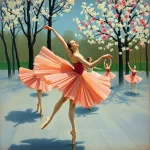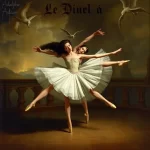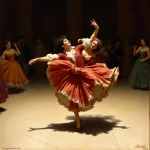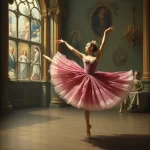Ballet: Le Sacre du printemps (The Rite of Spring) (Igor Stravinsky, 1913)

Introduction
Igor Stravinsky’s ballet Le Sacre du printemps (The Rite of Spring) is a landmark in the history of music and dance. Premiered on May 29, 1913, at the Théâtre des Champs-Élysées in Paris, the ballet was choreographed by Vaslav Nijinsky and composed by Stravinsky. The work is renowned for its avant-garde music and innovative choreography, which together depict a pagan ritual in which a young girl is chosen to dance herself to death as a sacrifice to the gods of spring.
Historical Background
Creation and Development
The early 20th century was a period of significant change and experimentation in the arts. The Ballets Russes, led by impresario Sergei Diaghilev, was at the forefront of this movement, pushing the boundaries of traditional ballet. Stravinsky, already known for his works The Firebird and Petrushka, was commissioned by Diaghilev to create a new ballet. Stravinsky drew inspiration from Russian folklore and pagan rituals, aiming to evoke the raw, primal energy of ancient rites.
The collaboration between Stravinsky and Nijinsky was crucial to the development of Le Sacre du printemps. Nijinsky’s choreography broke away from classical ballet conventions, incorporating angular movements and heavy, grounded steps that mirrored the music’s rhythmic complexity. The set and costume design by Nicholas Roerich also played a significant role, emphasizing the primitive and ritualistic themes of the ballet.
Premiere and Reception
The premiere of Le Sacre du printemps on May 29, 1913, at the Théâtre des Champs-Élysées in Paris is infamous for the riot it incited. The audience was shocked by the dissonant music, unconventional choreography, and the overall intensity of the performance. Critics were divided; some praised the bold innovation, while others condemned it as chaotic and unmusical. Despite the initial controversy, the ballet quickly gained recognition as a groundbreaking work.
Notable early performances included revivals by the Ballets Russes and later interpretations by various ballet companies worldwide. Each revival brought new insights and adaptations, solidifying the ballet’s place in the repertoire.
Synopsis of the Ballet
Le Sacre du printemps is a one-act ballet divided into two parts: “The Adoration of the Earth” and “The Sacrifice.”
Part I: The Adoration of the Earth
The ballet opens with a celebration of spring. The curtain rises to reveal a group of young men and women engaged in a series of ritualistic dances. The music is characterized by irregular rhythms and dissonant harmonies, reflecting the primal energy of the scene. Key moments include the “Augurs of Spring,” where the dancers stomp and jump in a frenzied display, and the “Ritual of Abduction,” where young women are seized by the men.
Part II: The Sacrifice
The second part of the ballet shifts to a darker, more solemn tone. The elders of the tribe gather to choose a sacrificial victim from among the young women. The chosen one, known as the “Chosen Maiden,” must dance herself to death to appease the gods of spring. The climax of the ballet is the “Sacrificial Dance,” where the Chosen Maiden performs a harrowing solo, culminating in her collapse and death.
Musical Composition
Composer’s Role
Igor Stravinsky’s contribution to Le Sacre du printemps cannot be overstated. His score is a masterpiece of modernist music, characterized by its complex rhythms, dissonant harmonies, and innovative orchestration. Stravinsky employed a large orchestra, including unusual instruments such as the bass clarinet and alto flute, to create a rich, textured sound.
Musical Themes and Motifs
The music of Le Sacre du printemps is built around recurring themes and motifs that enhance the narrative and emotional impact of the ballet. The “Augurs of Spring” theme, with its pounding rhythms and sharp accents, conveys the raw energy of the ritual. The “Sacrificial Dance” features jagged, unpredictable rhythms that mirror the Chosen Maiden’s frantic movements. Stravinsky’s use of folk melodies and modal harmonies adds an element of authenticity to the depiction of pagan rituals.
Famous Recordings and Performances
There have been numerous iconic recordings of Le Sacre du printemps, including those conducted by Stravinsky himself. Other notable recordings include those by Leonard Bernstein, Pierre Boulez, and Valery Gergiev. Each conductor brings their own interpretation to the score, highlighting different aspects of its complexity and power.
Choreography and Dance
Choreographer’s Vision
Vaslav Nijinsky’s choreography for Le Sacre du printemps was revolutionary. Rejecting the graceful, ethereal movements of classical ballet, Nijinsky created a style that was angular, grounded, and intensely physical. His choreography emphasized the connection between the dancers and the earth, reflecting the themes of fertility and sacrifice.
Signature Dance Numbers
Key dance numbers in the ballet include the “Augurs of Spring,” where the dancers’ stomping and jumping create a sense of primal energy, and the “Sacrificial Dance,” a solo performance that is both physically demanding and emotionally intense. These dances are not only central to the narrative but also showcase Nijinsky’s innovative choreography.
Notable Interpretations
Over the years, different productions have interpreted Nijinsky’s choreography in various ways. Some have stayed true to his original vision, while others have introduced new elements or reimagined the dances entirely. Notable reinterpretations include those by Pina Bausch, Maurice Béjart, and Sasha Waltz, each bringing their own unique perspective to the ballet.
Characters and Roles
Main Characters
- The Chosen Maiden: The central figure in the ballet, chosen to dance herself to death as a sacrifice to the gods of spring. Her role is both physically demanding and emotionally intense.
- The Elders: A group of tribal leaders who oversee the rituals and ultimately choose the sacrificial victim.
Supporting Characters
- The Young Men and Women: Participants in the various rituals and dances that make up the bulk of the ballet.
- The Tribe: The larger community that witnesses and participates in the rituals.
Famous Dancers
Notable dancers who have portrayed roles in Le Sacre du printemps include Maria Tallchief, who performed the Chosen Maiden in a 1950 revival, and more recently, dancers like Diana Vishneva and Natalia Osipova have brought their own interpretations to the role.
Cultural and Artistic Impact
Influence on Ballet and Dance
Le Sacre du printemps has had a profound influence on the world of ballet and dance. Its innovative choreography and music have inspired countless choreographers and composers. The ballet’s emphasis on raw, primal energy and its break from classical conventions paved the way for modern dance and contemporary ballet.
Cultural Significance
The ballet’s impact extends beyond the world of dance. It has been referenced in literature, film, and other media, often as a symbol of artistic innovation and rebellion. The music has been used in various contexts, from concert performances to film scores, further cementing its place in popular culture.
Legacy and Revivals
Le Sacre du printemps continues to be performed and celebrated today. Major revivals have included productions by the Joffrey Ballet, which recreated Nijinsky’s original choreography, and contemporary interpretations by companies like the Royal Ballet and the Mariinsky Ballet. Each new production brings fresh insights and keeps the ballet relevant for modern audiences.
Iconic Productions
Historic Productions
One of the most famous historical productions was the 1987 Joffrey Ballet revival, which meticulously reconstructed Nijinsky’s original choreography and Roerich’s designs. This production was significant for its historical accuracy and for bringing the original vision of the ballet to new audiences.
Contemporary Productions
Recent productions have continued to explore and reinterpret Le Sacre du printemps. The Royal Ballet’s 2011 production, choreographed by Wayne McGregor, introduced a modern, abstract interpretation of the ballet. Similarly, Sasha Waltz’s 2013 production incorporated elements of contemporary dance and multimedia, offering a fresh perspective on the classic work.
Production Design
Set, costume, and lighting design have played crucial roles in various productions of Le Sacre du printemps. Nicholas Roerich’s original designs emphasized the primitive and ritualistic themes, with earthy colors and traditional costumes. Modern productions have experimented with different design elements, from minimalist sets to elaborate multimedia installations, each adding a new layer of meaning to the ballet.
Critical Reception and Reviews
Initial Critical Response
The initial critical response to Le Sacre du printemps was mixed. While some critics praised its bold innovation, others were shocked by its dissonant music and unconventional choreography. The audience reaction was equally divided, with some members booing and others applauding.
Modern Reviews
Today, Le Sacre du printemps is widely regarded as a masterpiece. Contemporary critics and audiences appreciate its groundbreaking music and choreography, recognizing its influence on the development of modern dance and music. The ballet’s themes of ritual and sacrifice continue to resonate, making it relevant for new generations.
Fun Facts and Trivia
Behind-the-Scenes Stories
One of the most famous behind-the-scenes stories involves the riot at the premiere. Accounts vary, but it is generally agreed that the combination of Stravinsky’s dissonant music and Nijinsky’s radical choreography provoked a strong reaction from the audience, leading to shouting, fighting, and even police intervention.
Notable Performers
Over the years, many famous dancers, conductors, and directors have been associated with Le Sacre du printemps. In addition to Stravinsky and Nijinsky, notable figures include conductor Pierre Monteux, who led the orchestra at the premiere, and choreographer Pina Bausch, whose 1975 production is considered a landmark in modern dance.
Trivia
- The ballet’s original title was The Great Sacrifice.
- Stravinsky’s score was so complex that it required extensive rehearsals, with some musicians initially struggling to play the dissonant passages.
- The ballet has been adapted into various forms, including an animated segment in Disney’s Fantasia (1940).
Conclusion
Summary of the Ballet’s Importance
Le Sacre du printemps is a seminal work in the history of ballet and music. Its innovative choreography and groundbreaking score challenged traditional conventions and paved the way for modernist movements in both art forms. The ballet’s themes of ritual and sacrifice continue to resonate, making it a timeless piece that remains relevant today.
Final Thoughts
Le Sacre du printemps is more than just a ballet; it is a cultural phenomenon that has left an indelible mark on the arts. Its influence can be seen in countless works that followed, and its power to shock and inspire remains undiminished. For anyone interested in the evolution of dance and music, experiencing Le Sacre du printemps is essential.
FAQ
What is the central theme of this ballet?
The central theme of Le Sacre du printemps is a pagan ritual in which a young girl is chosen to dance herself to death as a sacrifice to the gods of spring.
Who are the main characters in this ballet?
The main characters include the Chosen Maiden, who is the sacrificial victim, and the Elders, who oversee the rituals.
What is the most famous dance number in this ballet?
The most famous dance number is the “Sacrificial Dance,” performed by the Chosen Maiden as she dances herself to death.
How long does a typical performance of this ballet last?
A typical performance of Le Sacre du printemps lasts about 35-40 minutes.
Are there any modern adaptations of this ballet?
Yes, there have been numerous modern adaptations, including those by choreographers Pina Bausch, Maurice Béjart, and Sasha Waltz.
Why is this ballet considered important in the history of dance?
Le Sacre du printemps is considered important because it broke away from classical ballet conventions, introducing new forms of movement and musical composition that have had a lasting impact on the development of modern dance and music.





